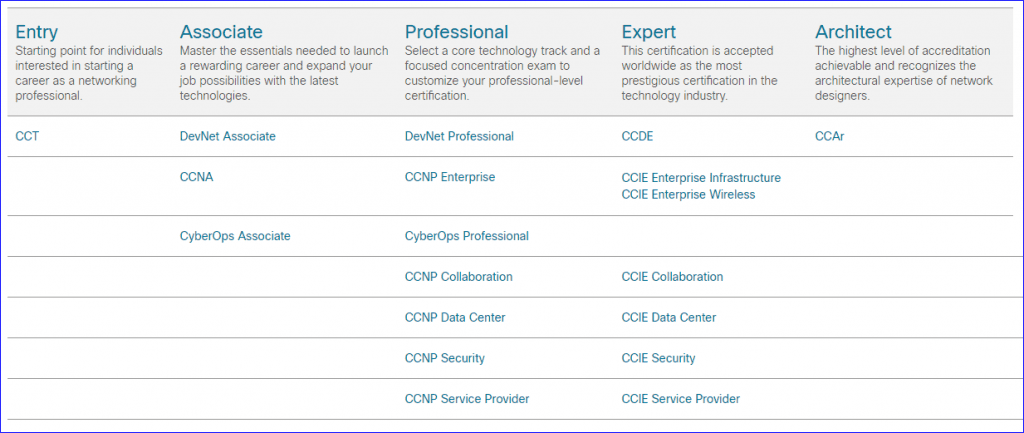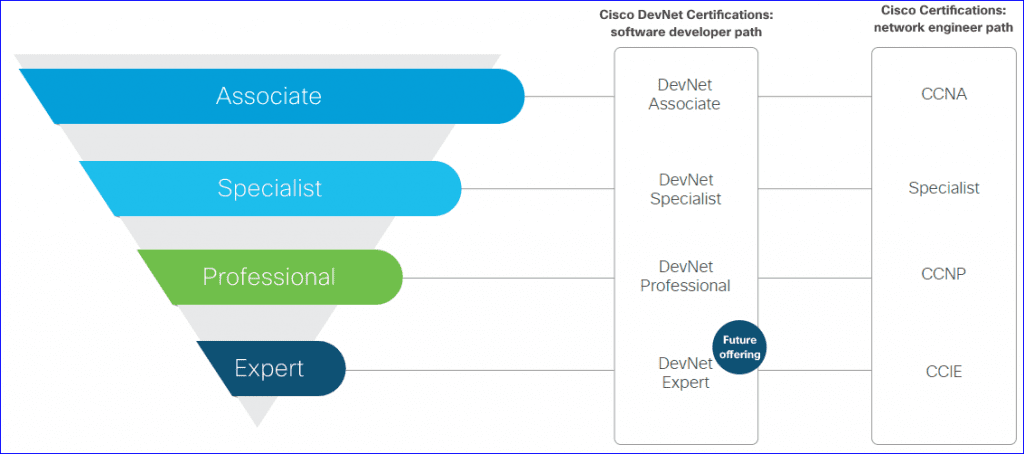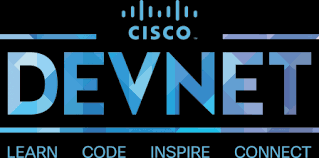Cisco memperbaiki beberapa sertifikasi yang paling kritis dan program pengembangan karier dalam upaya untuk mengatasi lingkungan jaringan yang berorientasi perangkat lunak yang muncul. Bersama Devnet, mereka meluncurkan sertifikat berbasis komunitas-developer.
Cisco memodifikasi beberapa sertifikasi yang paling penting miliknya. Hal ini dilakukan dalam rangka beradaptasi dengan lingkungan jaringan berorientasi perangkat lunak yang kini mulai dibutuhkan pasar.
Target dari DevNet adalah developer software dan engineer jaringan yang sedang mengembangkan kemampuan perangkat lunak untuk mengembangkan aplikasi dan alur kerja otomatis yang dapat di implementasikan dalam operasional jaringan dan infrastruktur.
Evolusi sertifikasi ini adalah langkah selanjutnya untuk mencerminkan keterampilan jaringan yang harus dimiliki oleh engineer jaringan yang berada di garis depan gangguan bisnis yang didukung jaringan dan memberikan keunggulan pelanggan,
Untuk tampil efektif di era baru seperti ini, setiap profesional TI membutuhkan keterampilan yang lebih luas, lebih dalam, dan lebih cepat daripada sebelumnya. Mereka juga harus menemukan kenyaman bekerja sebagai tim multidisiplin seperti Infrastructure network engineers, DevOps and Automation Specialist dan Software Professionals.
Cisco Certification
Berikut merupakan beberapa model sertifikasi terbaru dari Cisco, terkait beberapa model yang ditawarkan.

Sertifikasi yang disederhanakan untuk menyertifikasi profesional dengan sertifikasi Cisco Certified Network Associate (CCNA), Cisco Specialist serta Cisco Certified Network Professional (CCNP) dan sertifikasi Cisco Certified Internetwork Expert (CCIE) dalam kategori enteprise, data center, service provider, security dan collaboration.
Untuk profesional yang lebih senior, CCNP akan memberi peserta pilihan lima jalur. Jalur ini mencakup teknologi perusahaan termasuk infrastructure and wireless, service provider, data center, security dan collaboration. Mereka akan dapat lebih mengkhususkan diri dalam area fokus tertentu dalam teknologi tersebut.
Mereka mengatakan akan menghilangkan prasyarat untuk sertifikasi, artinya insinyur dapat mengubah opsi karier tanpa harus mengambil jalur yang ditentukan.
Perluasan penawaran Cisco Networking Academy untuk melatih profesional jaringan tingkat pemula dan developer software. Kursus mempersiapkan siswa untuk mendapatkan sertifikasi CCNA dan Certified DevNet Associate, untuk memenuhi permintaan pasar yang tinggi di bidang TI.
Beberapa level sertifikasi DevNet

Materi yang akan diberikan pada DevNet adalah sebagai berikut :

Topik yang dibahas
1.0 Software Development and Design
1.1 Compare data formats (XML, JSON, YAML)
1.2 Describe parsing of common data format (XML, JSON, YAML) to Python data structures
1.3 Describe the concepts of test-driven development
1.4 Compare software development methods (agile, lean, waterfall)
1.5 Explain the benefits of organizing code into methods/ functions, classes, and modules
1.6 Identify the advantages of common design patterns (MVC and Observer)
1.7 Explain the advantages of version control
1.8 Utilize common version control operations with Git:
1.8.a Clone
1.8.b Add/remove
1.8.c Commit
1.8.d Push / pull
1.8.e Branch
1.8.f Merge and handling conflicts
1.8.g diff
2.0 Understanding and Using APIs
2.1 Construct a REST API request to accomplish a task given API documentation
2.2 Describe common usage patterns related to webhooks
2.3 Identify the constraints when consuming APIs
2.4 Explain common HTTP response codes associated with REST APIs
2.5 Troubleshoot a problem given the HTTP response code, request and API documentation
2.6 Identify the parts of an HTTP response (response code, headers, body)
2.7 Utilize common API authentication mechanisms: basic, custom token, and API keys
2.8 Compare common API styles (REST, RPC, synchronous, and asynchronous)
2.9 Construct a Python script that calls a REST API using the requests library
3.0 Cisco Platforms and Development
3.1 Construct a Python script that uses a Cisco SDK given SDK documentation
3.2 Describe the capabilities of Cisco network management platforms and APIs (Meraki, Cisco DNA Center, ACI, Cisco SD-WAN, and NSO)
3.3 Describe the capabilities of Cisco compute management platforms and APIs (UCS Manager, UCS Director, and Intersight)
3.4 Describe the capabilities of Cisco collaboration platforms and APIs (Webex Teams, Webex devices, Cisco Unified Communication Manager including AXL and UDS interfaces, and Finesse)
3.5 Describe the capabilities of Cisco security platforms and APIs (Firepower, Umbrella, AMP, ISE, and ThreatGrid)
3.6 Describe the device level APIs and dynamic interfaces for IOS XE and NX-OS
3.7 Identify the appropriate DevNet resource for a given scenario (Sandbox, Code Exchange, support, forums, Learning Labs, and API documentation)
3.8 Apply concepts of model driven programmability (YANG, RESTCONF, and NETCONF) in a Cisco environment
3.9 Construct code to perform a specific operation based on a set of requirements and given API reference documentation such as these:
3.9.a Obtain a list of network devices by using Meraki, Cisco DNA Center, ACI, Cisco SD-WAN, or NSO
3.9.b Manage spaces, participants, and messages in Webex Teams
3.9.c Obtain a list of clients / hosts seen on a network using Meraki or Cisco DNA Center
4.0 Application Deployment and Security
4.1 Describe benefits of edge computing
4.2 Identify attributes of different application deployment models (private cloud, public cloud, hybrid cloud, and edge)
4.3 Identify the attributes of these application deployment types
4.3.a Virtual machines
4.3.b Bare metal
4.3.c Containers
4.4 Describe components for a CI/CD pipeline in application deployments
4.5 Construct a Python unit test
4.6 Interpret contents of a Dockerfile
4.7 Utilize Docker images in local developer environment
4.8 Identify application security issues related to secret protection, encryption (storage and transport), and data handling
4.9 Explain how firewall, DNS, load balancers, and reverse proxy in application deployment
4.10 Describe top OWASP threats (such as XSS, SQL injections, and CSRF)
4.11 Utilize Bash commands (file management, directory navigation, and environmental variables)
4.12 Identify the principles of DevOps practices
5.0 Infrastructure and Automation
5.1 Describe the value of model driven programmability for infrastructure automation
5.2 Compare controller-level to device-level management
5.3 Describe the use and roles of network simulation and test tools (such as VIRL and pyATS)
5.4 Describe the components and benefits of CI/CD pipeline in infrastructure automation
5.5 Describe principles of infrastructure as code
5.6 Describe the capabilities of automation tools such as Ansible, Puppet, Chef, and Cisco NSO
5.7 Identify the workflow being automated by a Python script that uses Cisco APIs including ACI, Meraki, Cisco DNA Center, or RESTCONF
5.8 Identify the workflow being automated by an Ansible playbook (management packages, user management related to services, basic service configuration, and start/stop)
5.9 Identify the workflow being automated by a bash script (such as file management, app install, user management, directory navigation)
5.10 Interpret the results of a RESTCONF or NETCONF query
5.11 Interpret basic YANG models
5.12 Interpret a unified diff
5.13 Describe the principles and benefits of a code review process
5.14 Interpret sequence diagram that includes API calls
6.0 Network Fundamentals
6.1 Describe the purpose and usage of MAC addresses and VLANs
6.2 Describe the purpose and usage of IP addresses, routes, subnet mask / prefix, and gateways
6.3 Describe the function of common networking components (such as switches, routers, firewalls, and load balancers)
6.4 Interpret a basic network topology diagram with elements such as switches, routers, firewalls, load balancers, and port values
6.5 Describe the function of management, data, and control planes in a network device
6.6 Describe the functionality of these IP Services: DHCP, DNS, NAT, SNMP, NTP
6.7 Recognize common protocol port values (such as, SSH, Telnet, HTTP, HTTPS, and NETCONF)
6.8 Identify cause of application connectivity issues (NAT problem, Transport Port blocked, proxy, and VPN)
6.9 Explain the impacts of network constraints on applications
Lab Environment
Adapun kebutuhan lab environment
- Mempersiapkan Virtualisasi –> Install Virtualbox
- Import DEVASC VM GUI –> Cisco Networking Academy DEVASC VM
- Membuat Akun Lab Environment
- Akun Devnet –> developer.cisco.com
- Akun Github –> github.com
- Akun Webex –> webex.com
